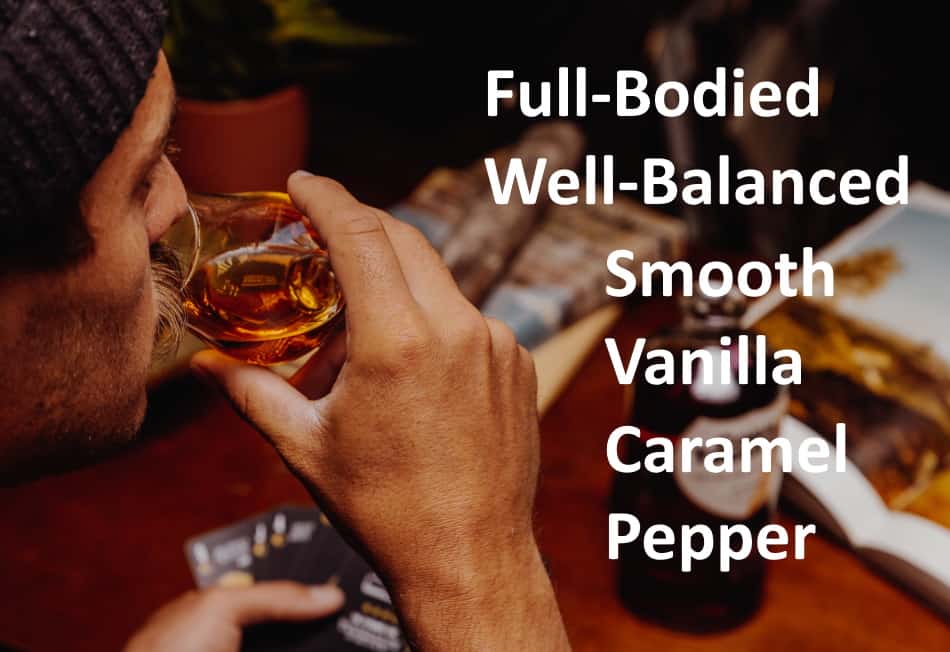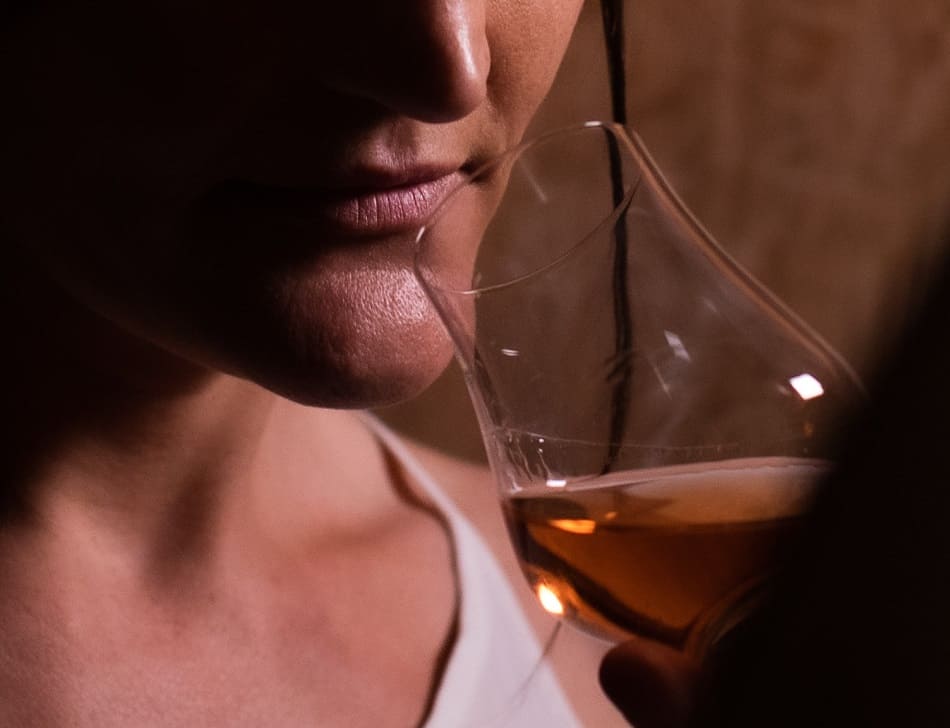I always found it difficult to describe the different aspects of whiskey, as I lacked the words to label them and a framework in which to explain how I perceived them. Fortunately, this has become easier over time and while the following guide is by no means a complete list, it is a useful starting point for learning how to describe the different aspects of whiskey.
Whiskey is described by identifying its color, aromas and flavors. Its color is often gold or amber. Common aromas and flavors are vanilla, caramel, honey, apple, pepper, cinnamon, nuts, chocolate and sherry. Other aspects of its taste in good whiskeys are; full-bodied, well-balanced, smooth and robust.
In the rest of this article, I’ll go into more detail about how to describe the different aspects of whiskey. I’ll give you a list of words you can use that will often be all you need and if not, something that will at least point you in the right direction.

How To Describe The Color Of Whiskey
Whiskeys are a shade of brown, which is a very dull way to describe its color. It’s also not very precise. More specific and interesting words for the color of whiskey are:
- Gold
- Amber
- Mahogany
- Honey
- Russet
- Copper
- Straw
These color descriptions can be further modified with the following adjectives:
- Light
- Bright
- Warm
- Medium
- Deep
- Burnished
And if you’re not sure what any of these specific colors look like, Whisky Magazine has created this useful 20-point whiskey color scale. It doesn’t include every way to describe the color of whiskey, but it does give you a lot of shades that you can use as a starting point.

Of course, you don’t have to keep to ordinary yet specific color descriptions. You can use descriptions that are as complex or unusual as you like. Not sure what I mean? Here are some real-life examples of how certain brands describe the color of some of their whiskeys, to give you an idea of what’s possible.
| Whiskey | Color Description |
|---|---|
| Aberlour 14 Years Old | Deep amber with honeyed gold |
| Auchentoshen 18 Years Old | Deep golden summer barley |
| Ballantine’s Barrel Smooth | Golden bonfire embers |
| Bruichladdich Islay Barley 2011 | Fresh cut straw |
| Bruichladdich The Classic Laddie | Sunlight on fields of early summer barley |
| Bruichladdich The Laddie Eight | Lemon marmalade |
| Bunnahabhain 30 Years Old | Golden syrup |
| Macallan Double Cask 12 Years Old | Harvest sun |
| Macallan Double Cask 15 Years Old | Golden butterscotch |
| Macallan Sherry Oak 40 Years Old | Autumn russet |
How To Describe The Smell Of Whiskey
For words to describe what whiskey smells like start by using a whiskey aroma wheel. These are diagrams of the most commonly used words to describe whiskey smells, grouped together in families with aromatic similarities. They will either give you the exact word you’re looking for, a description to build on or point you in the direction of the right word.
Whiskey aroma wheels work by having a number of top-level categories each of which have a handful of subcategories that in turn have several words that will help describe what you’re smelling.
The way to use a whiskey aroma wheel is by identifying which of the high-level category words best describes what you’re smelling. You then refine that description by identifying which of its subcategories the smell fits into and finally choose from the available words in that subcategory the descriptor you feel best matches what you’re smelling.
There are several different whiskey aroma wheels, one of which you can check out here , but for those who prefer not to have to stand on their head to read what it says, I’ve put that information into the following table:
, but for those who prefer not to have to stand on their head to read what it says, I’ve put that information into the following table:
| General | Subcategory | Descriptors |
|---|---|---|
| Grainy | Cereal | Breakfast cereal, porridge, bran, toast, digestive biscuits, coffee |
| Malt | Malted milk, malt barn, dried hops, Horlicks, Marmite | |
| Grassy | Fresh | Cut grass, green vegetables, green sticks, tomato, leafy, mint |
| Dried | Hay, straw, chaff, dried tea, stewed tea, tobacco, dried herbs | |
| Fragrant | Floral | Perfumed, rose, lavender, geranium, carnation, artificial floral |
| Solvent | Bubble-gum, peardrops, fresh paint, acetone, pine essence | |
| Honey | Clover flowers, heather pollen, heather honey, mead beeswax | |
| Fruity | Fresh Fruit | Apple, pear, peach, melon, fig, cherry, green banana, redcurrant |
| Citrus Fruit | Lemon, lime, orange mandarin, grapefruit, pineapple | |
| Dried Fruit | Raisins, sultanas, figs, mince pies, Xmas cake, marmalade | |
| Tinned Fruit | Peaches, pears, fruit salad, lychees, tiny | |
| Peaty | Maritime | Sphagnum moss, brine, seaweed, shellfish, fresh fish |
| Medicinal | Lint, Elastoplast, hospitals, mouthwash, antiseptic, iodine, creosote | |
| Smoky | Lapsong suchong tea, peat smoke, smoked salmon, kippers, tar | |
| Woody | Vanilla | Ice cream, custard, caramel, fudge, syrup, crème brulée |
| Spicy | Clove, nutmeg, cinnamon, liquorice, ginger, chilli, pepper, coffee | |
| New Wood | Sap, resin, sawdust, pencil shavings, cigar boxes, sandalwood | |
| Winey | Nutty | Coconut, nut oil, lineseed oil, almond, walnut, hazelnut |
| Oily | Cream, butter, vegetable oil, chocolate, olive, candlewax | |
| Vinous | White wine, sherry, Madeira, red wine, port, brandy, wine cellar | |
| Off Notes | Metallic | Vinegar, inky, tinny, wet iron, rusty |
| Musty | Earthy, fusty, mossy, mouldy, corked, damp wool, mothballs | |
| Vegetal | Brackish, stale, cabbage water, marsh gas, drains, bogs | |
| Cheesy | Cheese, fatty, rancid, goaty, mousey, yeasty, sweaty, vomit | |
| Meaty | Leather, cowhide, boiled pork, sausages, roast meat, gravy | |
| Sulphury | Linen, rubber, struck matches, cordite, fireworks, exhaust fumes |
Once you’ve gotten the hang of it, you can either expand on the descriptions in the whiskey aroma wheel by being even more specific (for example apples can become green apples and cherry can become glazed cherry) or come up with completely new descriptions of your own.
Also, it’s important to remember that the perception of smell is subjective and since smells are linked to memories, you can have your own personal descriptors that no one else would ever think of. And depending on your psyche, they may be quite unusual, for example the smell of the attic or grandad’s chair.

How To Describe The Taste Of Whiskey
You will immediately see that you can use the whiskey aroma wheel to describe the taste of whiskey too. Once again, it will either give you the exact word you’re looking for or point you in its direction. And you can expand on the descriptions or come up with new ones of your own.
To make things even easier here’s a short list of some common flavors found in whiskey:
- Honey
- Apple
- Vanilla
- Caramel
- Pepper
- Cinnamon
- Nutmeg
- Nuts
- Chocolate
- Sherry
When it comes to the taste of whiskey you don’t just need words to describe its flavors, you also need words to describe other aspects of the whiskey’s taste too.
Describing How the Flavors Are Present
You can describe the taste of your whiskey by how the flavors are present. For example:
- Full-bodied / Complex / Complex Flavor Profile – means a whiskey with several if not dozens of dominant flavors.
- Light-bodied – means a whiskey with only one or two dominant flavors.
- Bold – means a whiskey with flavors that are bold, rich and intense.
- Light – means a whiskey with flavors that are light, delicate or mild.
- Well-Balanced – means a whiskey where the flavors work well together and complement each other without one overpowering the others.
Describing The Flavors by A Defining Characteristic
You can describe the taste of your whiskey by one defining characteristic. For example:
- Sweet – The whiskey has sweet flavors.
- Spicy – The whiskey has spicy flavors.
- Fruity – The whiskey has fruity flavors.
- Floral – The whiskey has flowery flavors.
- Briny – The whiskey has the flavors of briny sea air.
- Smoky / Peaty – The whiskey has a smoky or peaty flavor from the peat used to dry the kiln during the malting process.
Describing The Taste by How It Feels in Your Mouth
You can describe the taste of your whiskey by how it feels in your mouth (called the mouthfeel). For example:
- Thin / Watery
- Rich / Round / Full / Thick
- Soft / Oily / Creamy / Silky / Velvety
Describing The Taste of The Alcohol
You can describe the taste of your whiskey by how you perceive the alcohol:
- Smooth / Mellow / Soft means it has no alcohol burn.
- Harsh / Ethanol / Burning means it has too much alcohol bite.
Describing The Overall Taste of Your Whiskey
And you can describe the overall taste of your whiskey:
- Round – means a whiskey with balanced aromas, flavors, and mouthfeel.
- Robust – means a whiskey with intense aromas, full-flavor and a powerful character.
- Soft – means a whiskey with subtle aromas and flavors.
